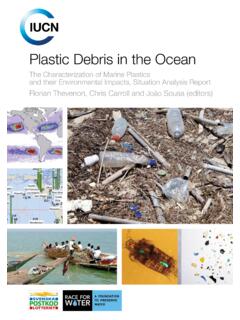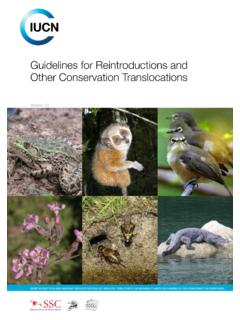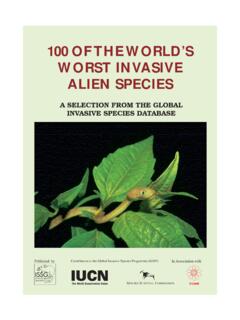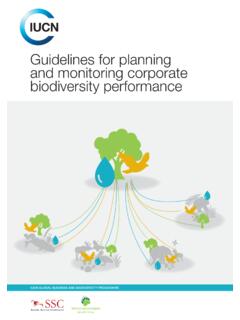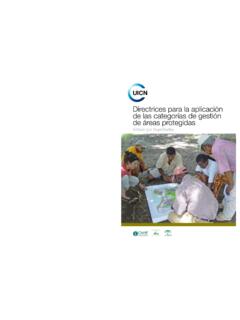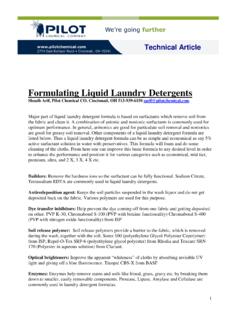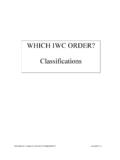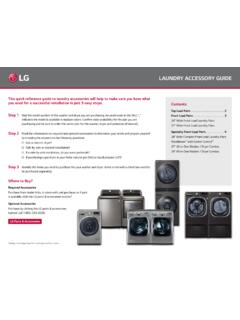Transcription of Primary Microplastics in the Oceans
1 InternatIonal UnIon for ConservatIon of natUrea Global Evaluation of SourcesAuthors: Julien Boucher, Damien FriotPrimary Microplastics in the Oceans : Primary Microplastics in the Oceans :a Global Evaluation of SourcesAuthors: Julien Boucher, Damien FriotThe designation of geographical entities in this book, and the presentation of the material, do not imply the expression of any opinion whatsoever on the part of IUCN concerning the legal status of any country, territory, or area, or of its authorities, or concerning the delimitation of its frontiers or views expressed in this publication do not necessarily reflect those of by: IUCN, Gland, SwitzerlandCopyright: 2017 International Union for Conservation of Nature and Natural Resources Reproduction of this publication for educational or other non-commercial purposes is authorised without prior written permission from the copyright holder provided the source is fully acknowledged.
2 Reproduction of this publication for resale or other commercial purposes is prohibited without prior written permission of the copyright : Boucher, J. and Friot D. (2017). Primary Microplastics in the Oceans : A Global Evaluation of Sources. Gland, Switzerland: IUCN. : 978-2-8317-1827-9 DOI: : Julien Boucher EA Shaping Environmental Action & University of Applied Sciences and Arts Western Switzerland // HES-SO, HEIG-VD, Yverdon-les-Bains, Switzerland Damien Friot EA Shaping Environmental Action Carl Gustaf Lundin and Jo o Matos de SousaExternal reviewers: Francis Vorhies (Earthmind, ) Fran ois Galgani (IFREMER, Laboratoire LER/PAC) Mathieu Pernice (University of Technology, Sydney) Doug Woodring ( ) Designed by: Imre Sebesty n jr. (Unit Graphics Studio)Available from: Microplastics In the Oceans : A GlobAl EvAluAtion of SourcESTable of conTenTsForeword 4 1.
3 Abstract 52. Introduction 72 1 Plastics & Microplastics contaminate the world ocean 82 2 Knowledge gaps about Microplastics releases 82 3 Rapidly increasing use of plastics 92 4 Objective of this report 103. Description of issues & methodology 113 1 Literature review of key sources 123 2 A lifecycle perspective of losses 133 3 Description of seven key sources 143 4 Modelling activities, losses & releases 173 5 Three scenarios for presenting the results 184.
4 Results & Analysis 194 1 Primary Microplastics are a significant source of plastic in the Oceans 204 2 Two-thirds of the releases are from the erosion of synthetic textiles & tyres 214 3 Household activities generate almost three quarters of the releases during the use phase and maintenance of plastic products 234 4 Two-thirds of the losses are through road runoffs 244 5 All regions contribute significantly to releases 254 6 Releases average one plastic bag per person per week 264 7 Key sources of releases differ among regions 274 8 Microplastic releases are high in Europe & North America 284 9 Closing the plastic tap requires different sets of solutions 295.
5 Conclusion 305 1 Take home messages 315 2 Shaping action to close the plastic tap 315 3 Next steps 326. Appendix 1: Sources 336 1 Synthetic textiles: abrasion during laundry 346 2 Tyres: abrasion while driving 346 3 City dust: spills, weathering & abrasion 356 4 Road markings: weathering and abrasion by vehicles 366 5 Marine coatings: weathering, application & maintenance 366 6 Personal care products.
6 Loss during use 376 7 Plastic Pellets: manufacturing, transport & recycling 377. Appendix 2: Pathways 387 1 Road runoff pathway 397 2 Wastewater Pathway 397 3 Wind pathway 397 4 Ocean Pathway 398.
7 Appendix 3: Regions 40 9. Bibliography 424 Primary Microplastics In the Oceans : A GlobAl EvAluAtion of SourcESforewordThe invention of plastic based on a synthetic polymer in 1907 changed our lives forever for better and for worse. Plastic is one of the most versatile materials ever produced and has revolutionised the way we package, eat, travel and dress. The plastic revolution has however come at a cost. Plastic pollution in our marine environment is taking place on a staggering scale with million tonnes of new plastic waste flowing into the ocean each year. This is impacting our planet s precious biodiversity and damaging the fragile ecosystems upon which we all depend.
8 The widespread contamination of our Oceans is also fast becoming a worldwide human health risk as plastic enters our food and water supplies. Despite a growing body of work on plastic debris and a heightened global awareness of its global impact, remedial efforts to combat this pollution have been hamstrung by a lack of research and knowledge surrounding the original sources of the waste Microplastics in the Oceans : a Global Evaluation of Sources helps fill this knowledge gap and provides an important reference point for decision makers as they design and implement the transformative policies and production practices we need to transition towards a circular global economy. Following in the footsteps of the IUCN Close the plastic tap project and the Plastic debris in the ocean publication, this report provides a global estimate and mapping of the sources and quantities of Primary Microplastics plastics that enter the Oceans in the form of small particles released from household and industrial mismanaged plastic waste is still the main source of marine plastic pollution globally, this report shows for the first time that, in some countries, more plastic may be released from our driving and washing activities than from the mismanagement of our waste.
9 Tackling the multitude of sources of marine plastics requires a holistic approach that addresses the problem at its source. The findings in this report must drive new thinking around the way we design, produce, consume and dispose of plastics. Action to turn off the plastic tap could come in the form of new engineered materials and smart design, such as clothes that shed fewer fibres or washing machines equipped with filters. These efforts must be supported by legislation and on-the-ground policies that force real change. This report also reminds us that, as consumers of plastic, we have a responsibility to educate ourselves and adapt our behaviour in order to protect our blue have a major challenge ahead. But with a collaborative global effort, we can reverse the grim forecasts for plastic pollution, and return to a world with healthy Oceans .
10 Inger Andersen, IUCN Director GeneralThis report owes its existence to the outstanding support from MAVA Fondation pour la Nature The Swedish Postcode Foundation and the Gallifrey Foundation are also acknowledged for supporting the launch of this report 5 Primary Microplastics In the Oceans : A GlobAl EvAluAtion of SourcES1. AbstractPlastic has penetrated everyday life: from clothing to coatings and from transport vehicles to cleaning products Plastic is cheap, durable, lightweight and malleable, resulting in a practically unlimited number of possible applications The disadvantages of plastics however are becoming more and more visible Large quantities of plastics leak into rivers and Oceans , with adverse effects to marine ecosystems and related economic activities Plastic wastes include all size residues, from large visible and easily removable items, to small invisible particles This report investigates the sources of Primary Microplastics i e Microplastics that are directly released into the environment as small plastic particles (< 5 mm size)


